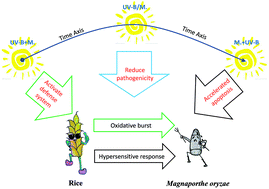当前位置:
X-MOL 学术
›
Photochem. Photobiol. Sci.
›
论文详情
Our official English website, www.x-mol.net, welcomes your
feedback! (Note: you will need to create a separate account there.)
Effects of enhanced UV-B radiation on the interaction between rice and Magnaporthe oryzae in Yuanyang terrace
Photochemical & Photobiological Sciences ( IF 2.7 ) Pub Date : 2019-10-12 , DOI: 10.1039/c8pp00556g Xiang Li 1, 2, 3, 4 , Lanlin Huang 1, 2, 3, 4 , Yongmei He 1, 2, 3, 4 , Chunmei Xie 1, 2, 3, 4 , Fangdong Zhan 1, 2, 3, 4 , Yanqun Zu 1, 2, 3, 4 , Jianjun Sheng 1, 2, 3, 4 , Yuan Li 1, 2, 3, 4
Photochemical & Photobiological Sciences ( IF 2.7 ) Pub Date : 2019-10-12 , DOI: 10.1039/c8pp00556g Xiang Li 1, 2, 3, 4 , Lanlin Huang 1, 2, 3, 4 , Yongmei He 1, 2, 3, 4 , Chunmei Xie 1, 2, 3, 4 , Fangdong Zhan 1, 2, 3, 4 , Yanqun Zu 1, 2, 3, 4 , Jianjun Sheng 1, 2, 3, 4 , Yuan Li 1, 2, 3, 4
Affiliation

|
Enhanced ultraviolet–B (UV-B) radiation affected the growth of rice and Magnaporthe oryzae, and changed the interactions between them. Increased UV-B radiation (5.0 kJ m−2 d−1) on rice leaves in a Yuanyang terrace was conducted before, during, and after infection of the leaves with Magnaporthe oryzae. The relationship between rice blast and UV-B radiation on the disease resistance of rice and the pathogenicity of M. oryzae was studied, and the effects of enhanced UV-B radiation on the interactions between rice and M. oryzae were analysed. The results indicated the following: (1) enhanced UV-B radiation significantly reduced the rice blast disease index, but as infection progressed, the inhibitory effect of UV-B radiation on the disease was weakened. (2) UV-B radiation treatment before infection with M. oryzae (UV-B + M.) significantly increased the activity of the enzymes related to disease resistance (phenylalanine ammonia lyase, lipoxygenase, chitinase, and β-1,3-glucanase), and the plants exhibited light-induced resistance. (3) Exposure to UV-B radiation after M. oryzae infection (M. + UV-B) did not induce disease course-related protein (PR) activity, but the content of soluble sugar increased. The osmotic stress caused by pathogenic fungi infection was alleviated by active accumulation of soluble sugar; due to this lack of nutrients, it was difficult for the rice blast fungus to grow. (4) Enhanced UV-B radiation significantly inhibited the production of conidia by M. oryzae, and the expression of the pathogenic genes Chitinase, MGP1, MAGB, and CPKA was significantly downregulated. The pathogenicity of M. oryzae was reduced by UV-B radiation. The resistance of rice leaves was weakened by simultaneous exposure to UV-B radiation and M. oryzae (UV-B/M.). Hence, UV-B radiation can weaken the infectivity of M. oryzae, improve the resistance of traditional rice, and contain the disease.
中文翻译:

UV-B辐射增强对Yuan阳梯田 水稻与稻瘟病菌相互作用的影响
增强的紫外线-B(UV-B)辐射影响水稻和稻瘟病菌的生长,并改变了它们之间的相互作用。在用稻瘟病菌感染水稻之前,期间和之后,在元阳阶地的水稻叶片上增加了UV-B辐射(5.0 kJ m -2 d -1)。研究了稻瘟病和UV-B辐射对水稻的抗病性与稻瘟病菌致病性的关系,并研究了增强的UV-B辐射对水稻与稻瘟病菌相互作用的影响。被分析。结果表明:(1)增强的UV-B辐射显着降低了稻瘟病指数,但随着感染的进行,UV-B辐射对该病的抑制作用减弱。(2)稻瘟病菌感染前的UV-B辐射治疗(UV-B + M.)显着提高了与疾病抗性相关的酶的活性(苯丙氨酸氨裂合酶,脂氧合酶,几丁质酶和β-1,3-葡聚糖酶) ),并且植物表现出光诱导的抗性。(3)稻瘟病菌暴露于UV-B辐射感染(M. + UV-B)不会诱导病程相关蛋白(PR)活性,但是可溶性糖含量增加。可溶性糖的主动积累减轻了病原性真菌感染引起的渗透胁迫。由于缺乏营养,稻瘟病菌难以生长。(4)增强的UV-B辐射显着抑制了米曲霉分生孢子的产生,致病基因几丁质酶,MGP1,MAGB和CPKA的表达均显着下调。UV-B辐射降低了米曲霉的致病性。同时暴露于UV-B辐射和米曲霉(UV-B / M。)。因此,UV-B辐射可以削弱米曲霉的传染性,提高传统水稻的抗性,并遏制该病。
更新日期:2019-12-04
中文翻译:

UV-B辐射增强对Yuan阳梯田 水稻与稻瘟病菌相互作用的影响
增强的紫外线-B(UV-B)辐射影响水稻和稻瘟病菌的生长,并改变了它们之间的相互作用。在用稻瘟病菌感染水稻之前,期间和之后,在元阳阶地的水稻叶片上增加了UV-B辐射(5.0 kJ m -2 d -1)。研究了稻瘟病和UV-B辐射对水稻的抗病性与稻瘟病菌致病性的关系,并研究了增强的UV-B辐射对水稻与稻瘟病菌相互作用的影响。被分析。结果表明:(1)增强的UV-B辐射显着降低了稻瘟病指数,但随着感染的进行,UV-B辐射对该病的抑制作用减弱。(2)稻瘟病菌感染前的UV-B辐射治疗(UV-B + M.)显着提高了与疾病抗性相关的酶的活性(苯丙氨酸氨裂合酶,脂氧合酶,几丁质酶和β-1,3-葡聚糖酶) ),并且植物表现出光诱导的抗性。(3)稻瘟病菌暴露于UV-B辐射感染(M. + UV-B)不会诱导病程相关蛋白(PR)活性,但是可溶性糖含量增加。可溶性糖的主动积累减轻了病原性真菌感染引起的渗透胁迫。由于缺乏营养,稻瘟病菌难以生长。(4)增强的UV-B辐射显着抑制了米曲霉分生孢子的产生,致病基因几丁质酶,MGP1,MAGB和CPKA的表达均显着下调。UV-B辐射降低了米曲霉的致病性。同时暴露于UV-B辐射和米曲霉(UV-B / M。)。因此,UV-B辐射可以削弱米曲霉的传染性,提高传统水稻的抗性,并遏制该病。











































 京公网安备 11010802027423号
京公网安备 11010802027423号